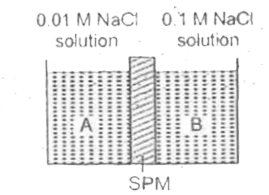Two chambers A & Bm separated by a semipermeable membrane, contain respectively 1M glucose solution and 2M glucose solution. In this condition net water movement is form A to B. If solution os chamber B is replaced by 1M NaCl solution then:
net water movement will remain same i.e.A to B
their will be no net water movement because bith the solution A and B will have same concentration
net water movement will become B to A
semipermeable membrane will not function properly because both the solutions A and B will have different solutes
The correct Answer is:A
To solve the problem, we need to analyze the situation step by step, focusing on the concepts of osmolarity and water movement across a semipermeable membrane.
1. Understanding the Initial Conditions:
- Chamber A contains a 1M glucose solution.
- Chamber B contains a 2M glucose solution.
- Since the concentration of solute (glucose) is higher in Chamber B, water will move from Chamber A (lower solute concentration) to Chamber B (higher solute concentration) due to osmosis.
Hint: Remember that water moves from areas of low solute concentration to areas of high solute concentration.
2. Replacing the Solution in Chamber B:
- The solution in Chamber B is replaced with a 1M NaCl solution.
- NaCl dissociates into Na⁺ and Cl⁻ ions in solution, effectively doubling the number of particles in the solution.
Hint: Consider how solutes dissociate in solution when calculating osmolarity.
3. Calculating Osmolarity:
- For the 1M glucose solution in Chamber A, the osmolarity is 1 osmolar (since glucose does not dissociate).
- For the 1M NaCl solution in Chamber B, the osmolarity is 2 osmolar (1M Na⁺ + 1M Cl⁻ = 2 osmolar).
Hint: Osmolarity is the total concentration of solute particles in a solution.
4. Determining Water Movement:
- Since the osmolarity in Chamber A (1 osmolar) is less than that in Chamber B (2 osmolar), water will move from Chamber A to Chamber B.
- This movement occurs because water moves from areas of lower osmolarity to areas of higher osmolarity.
Hint: Water movement is influenced by osmolarity, not just solute concentration.
5. Conclusion:
- The net water movement will remain the same, which is from Chamber A to Chamber B.
Final Answer:
The net water movement will remain the same, that is, from Chamber A to Chamber B.
- Chamber A contains a 1M glucose solution.
- Chamber B contains a 2M glucose solution.
- Since the concentration of solute (glucose) is higher in Chamber B, water will move from Chamber A (lower solute concentration) to Chamber B (higher solute concentration) due to osmosis.
- The solution in Chamber B is replaced with a 1M NaCl solution.
- NaCl dissociates into Na⁺ and Cl⁻ ions in solution, effectively doubling the number of particles in the solution.
- For the 1M glucose solution in Chamber A, the osmolarity is 1 osmolar (since glucose does not dissociate).
- For the 1M NaCl solution in Chamber B, the osmolarity is 2 osmolar (1M Na⁺ + 1M Cl⁻ = 2 osmolar).
- Since the osmolarity in Chamber A (1 osmolar) is less than that in Chamber B (2 osmolar), water will move from Chamber A to Chamber B.
- This movement occurs because water moves from areas of lower osmolarity to areas of higher osmolarity.
- The net water movement will remain the same, which is from Chamber A to Chamber B.
The net water movement will remain the same, that is, from Chamber A to Chamber B.
Topper's Solved these Questions
Similar Questions
Knowledge Check
0.5 M aquous solution of Glucose is isotonic with:
A0.5 M KCl solutionB0.5 M CaCl2 solutionC0.5 M Urea solutionD1 M solution of sucroseTwo solutions A and B are separated by semipermeable membrane. If liquid flows from A to B then
AA is more concentrated than BBA is less concentrated than BCboth solutions have same concentrationDnoneTwo solutions A and B are separated by semipermeable membrane. If liquid flows from A to B, than
AA is less concentrated than BBA is more concentrated than BCBoth have same concentrationDVolume of A is more than that of B
Two solutions A and B are separated by semipermeable membrane. If liquid flows from A to B, than
View SolutionThe osmotic pressure of 0.1 M glucose and 0.1 M sucrose solution are the same because
View SolutionMixture containing 100mL of 1M urea solution and 300mL of 1M glucose solution at TK will have osmotic pressure:
View SolutionTwo solutions marked as A and B are separated through semipermeable membrane as below. The phenomenon undergoing

View Solution1MNaCl and 1MHCl are present in an aqueous solution. The solution is
View Solution